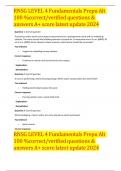Exam (elaborations)
TEST BANK PEDIATRIC NURSING: A Case-Based Approach 1ST EDITION By Gannon Tagher; Lisa Knapp ISBN- 978-1496394224
- Course
- Institution
- Book
TEST BANK PEDIATRIC NURSING: A Case-Based Approach 1ST EDITION By Gannon Tagher; Lisa Knapp ISBN- 978-4 TEST BANK PEDIATRIC NURSING: A Case-Based Approach 1ST EDITION By Gannon Tagher; Lisa Knapp ISBN- 978-4
[Show more]












